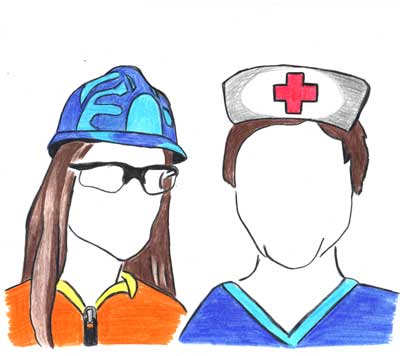The staff editorial is the majority opinion of The Murray State News Editorial Board.

Two news articles in this week’s paper deal with gender roles in specific industries – medical, science, technology, engineering and math, to be specific.
Some industries are making progress in regard to diversity and gender-inclusion and others continue to struggle.
Nursing, for instance, is breaking down one large stereotypical wall: nursing is a woman’s profession.
Murray State’s nursing program is contributing to this progress in an impressive way, as 33 percent of the December graduating nursing class are men. Furthermore, the American Assembly for Men in Nursing strives to see a 20 percent growth in the number of male nurses within the next five years.
The main reasons identified for the increase in gender diversity in nursing is the attraction of the constantly growing job market and the strong economic return available almost immediately to nurses entering the field.
Nurses have always been in high demand, though – that hasn’t changed. So why the peak in male interest?
Our hope was that people are finally getting past the notion that nurses have to be matronly, motherly figures – caretakers, instead of the life-saving medical professionals they really are, regardless of gender.
This hope was tainted slightly when we realized that despite this progress, one fault still stands: the gender pay gap.
Male nurses reportedly make almost $5,000 more a year than their female colleagues, according to USA TODAY.
Also, as stated in a press release sent out by Murray State about the increase of male nursing graduates, one of the benefits of having more male nurses is that they will not only offer “different perspectives and ideas,” but they will “offer increased physical ability.”
So, between the pay gap and the emphasis on the stereotype that men are inherently strong and more able-bodied than women, how much progress are we really making? What’s the point of striking down some gender stereotypes while pandering to others?
Which brings us to the article about the need for more women in STEM (science, technology, engineering and math) industries.
Let’s look at the facts, as reported by the U.S. Bureau of Labor Statistics:
- Women in chemistry and material sciences: 39 percent
- Women in computer and mathematical occupations: 26 percent
- Women in engineering: 14 percent
Just as men are the minority in nursing, women are the minority in STEM industries – in some cases, the vast minority.
This is apparently due to a lack of encouragement for women to enter these professions and an even bigger lack of female role models. Murray State is a prime example of this: women make up a menial 17 percent of science, engineering and technology departments faculty members.
Thus, women who may have the potential and the passion to do great things in STEM fields look yet another male-dominated world in the eye and back away. It’s not cowardice – it’s instinct.
And again, when the benefits the minority gender would have on the industry were brought up, stereotypes were upheld. Because not only would women in STEM fields bring a “new perspective,” but women “have not as much pride,” are “more gentle … helpful and organized,” and are “more of a caretaker,” said Pamela Guerrero, a Murray State graduate student and high school math and science teacher.
So we’re back at square one.
Nursing and STEM professions may or may not advance in terms of numbers and statistics, but when will we see true, genuine progress in the roles human beings play in these important industries, regardless of gender?
Yes, a lot of men are strong. But so are a lot of women.
Yes, a lot of women are gentle and caring. But so are a lot of men.
When did stereotypical gender roles become both weaknesses and strengths? When will our body parts stop designating our qualifications? Will that glass ceiling always loom over us?